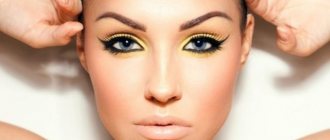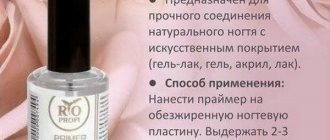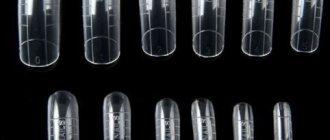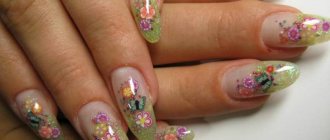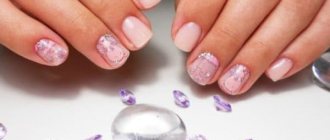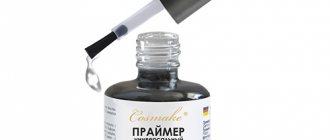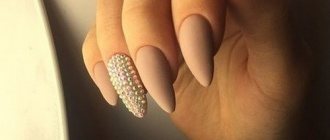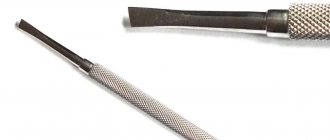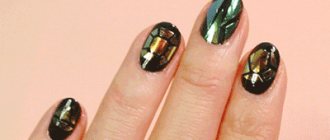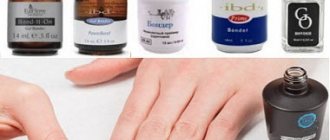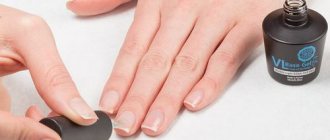In order for the decorative coating in the form of gel polish to remain on the nails for a long time in the same condition, you should pay attention to all stages of the procedure, including applying a primer as a zero layer before the base. But not all nail technicians follow this rule, which affects the durability of the work.
In addition, they do not always know the difference between an acid primer and an acid-free one for nails, although the quality of the work, including its visual condition and duration of preservation, depends on the type of composition.
What are primers for?
The primer is considered one of the basic tools and must be used by every nail technician who works with acrylic and gel coatings. This is an indispensable thing in modeling nails with shellac and acrylic. Its main function is to degrease the nail surface and maximize the adhesion of the base compounds applied to the plate.
In addition, the primer effectively disinfects nails and reduces to zero the risk of developing pathogenic microflora under the acrylic/gel coating. Depending on the type of product, its effect may be broader (for example, the nail plate is additionally dried, the product does not affect the color of the decorative coating, etc.).
The process of nail extension is represented by several stages and must necessarily include certain products. Primer is one of these and is always applied immediately after the dehydrator (directly with the base). Speaking of low fat. Why do this? If this is not done, the adhesion of the nail plate to the base coat will not be as strong (which can lead to possible damage and deterioration of its appearance). In addition (and this is perhaps a vital point), the product in question prevents the development of a fungal environment under the coating.
Important. If you do not use a primer when creating an acrylic/gel coating, in the process of wearing it, real onychomycosis and even panacirium (inflammation of the tissues of the fingers) can develop.
All primers are divided into 2 groups: acidic and acid-free. The former are considered aggressive compounds and are suitable only for healthy (!), strong nails. The second are generalists. After application, such compositions change the pH of the plate, bringing it closer to the pH of the coating. Separately, we can highlight bonds that do not contain aggressive components and are considered the best option for very weak nails. As a rule, they are used before applying gel polish (or classic), or one of the two primers presented above.
Subtleties of working with primer
When using a primer when modeling nails, it is worth considering the following recommendations that will make the final version of the work flawless.
- Regardless of the type of primer, the use of an ultraviolet lamp for drying is not required. The components that make up the product dry out within 1-2 minutes when exposed to natural light. When using an acidic primer, the presence of a white tint on the nails indicates that the product has completely dried, and if an acid-free primer was used, the surface of the nail should not contain wet areas. Until the primer dries completely, prevent the treated nails from coming into contact with the skin.
- All actions with the degreaser are careful and use a small amount of product. The nail coating is carried out by applying the composition with a professional brush for working with primers, which in most cases is sold complete with the preparation. If the primer was purchased in economy packaging, you should separately purchase a special brush for applying it to your nails. To distribute the product evenly, you should point the brush to the nail.
- When applying primer to a natural area of the nail, it is necessary to exclude the possibility of the substance getting on the tip. Exposure to the chemical components that make up the drug can cause deterioration in the strength of the substrate and lead to its breakage or crack formation.
- When ascertaining the primer with the skin, it is worth immediately treating the affected area with a soap solution, followed by rinsing under clean running water. This will eliminate the possibility of symptoms of irritation, redness of the skin and, in the worst case, the development of an allergic reaction on the upper layers of the epidermis.
Regardless of the type, any primer is an aggressive substance. But, with strict adherence to safety precautions and rules for using this drug, working with it will be easy and harmless.
Professional craftsmen recommend not to experiment and when choosing a primer to give preference to well-known manufacturers who are responsible for the quality of their products, guaranteeing the absence of negative effects on the body.
Acid-free primer (ultrabond): features, application technique
The acid-free version is considered the safest base product used for nail extensions. It is a hypoallergenic, gentle cosmetic product that effectively degreases the nail plate without changing its pH level. An acid-free primer is considered to some extent a universal product that has a number of undoubted advantages:
- Maintains the original pH level of the nail plate without thinning it;
- Does not affect the color of the base coat;
- Suitable even for thin and peeling nails;
- It is convenient to use because it dries quickly, without requiring drying in an ultraviolet lamp.
Who is acid-free primer suitable for? For those with dry skin, thin, weak, easily peeling nails, as well as people prone to allergies.
How to apply the product correctly? There are no particular difficulties in this process: a small amount of the base product is applied with a brush to the entire surface of the nail, starting from its center, which will allow the composition to be evenly distributed. It is important to act very carefully, carefully working the nail, to avoid getting the product on the side ridges and cuticle (never use a UV lamp for drying!). It is enough to hold the applied composition in the air for several minutes. How do you know if the primer is completely dry? It is enough to make sure that there are no wet areas left on the nails.
Although the acid-free primer does not contain toxic methacrylic acid, it is still considered a toxic substance, so you should be careful when working with it: be sure to wear a mask with good filters or a respirator and avoid getting the product on your skin.
Prevention
The best preventive measure is the correct storage of chemical reagents, in particular acids and alkalis. By following workplace instructions and safety regulations, it is possible to completely eliminate the possibility of contact of aggressive substances with skin.
For this purpose, there are special working protective clothing and shoes. Before starting to work with an unknown substance, you must study the instructions for use in detail. Work with reagents is carried out using protective screens, glasses and gloves. If necessary, use masks or respirators.
For many women, nail extensions are the only way to get their nails in order. With the help of special tools and devices, the master can easily create a beautiful and neat manicure. The main stage of nail plate care is the use of a primer.
Acid primer: what is it, nuances when working
An acid primer is a more aggressive base product than an acid-free primer. This product contains a certain amount of methacrylic acid, which is considered a toxic substance, but in acidic primers it does not pose a danger to the nail plate (the concentration is negligible). It is often used for acrylic nail extensions.
The main task of an acidic product is completely identical to that performed by an acid-free one: cleansing the nail plates of fat, drawing out moisture, enhancing adhesion to the material, protecting against potential problems when wearing the coating for a long time (fungus, the appearance of cracks and delaminations on the nail, etc.).
Features of acid primer:
- Strong adhesion of the working material to the nail surface due to the ability of the product to open the scales of the nail, making it rough;
- Ideal base product for acrylic coating.
- Who is suitable for acid primer? For those with oily nail plates and those whose hands often sweat.
How to apply the product correctly? Despite the scanty content of methacrylic acid in the primer, contact with it should be very careful, since the substance is toxic. Be sure to wear a mask with protective filters or a respirator, and avoid contact with skin. The product must be applied in a very thin layer, since the active substance in its composition can soften the nail plate.
To avoid picking up too much product, it is important to carefully squeeze the brush against the edge of the jar, and then be sure to blot it with a lint-free napkin. Only after this can you apply the composition to the nail using pointed movements. You should always start from the center so that the product can be evenly distributed over the nail plate. It is important to make sure the primer is completely dry before applying the base. How to determine this? After drying, the acid composition forms a white “mark” on the nails.
What is the difference
There are two types of nail primers - acidic and acid-free. They differ in composition, effectiveness and results. The scope of their application and compatibility with one or another artificial agent may also differ.
Acidic primers
Acidic primers tend to aggressively degrease nails, thereby affecting the structure. They are 80% methacrylic acid. Accordingly, if used incorrectly, they can cause significant damage to both the nail and the skin around it.
When used at home, you can often find user reviews that talk about getting a chemical burn to the skin and damaging the structure of the plate. But despite all this, one cannot say that they are bad. They are actually quite effective when used by professionals. Therefore, the range of their application is in salons and offices where manicures are performed professionally.
It is important to understand that acid primers are based on a toxic substance that is only used for acrylic extensions. Strictly speaking, this is the only cosmetic product that allows you to carry out this procedure efficiently and, as a result, get beautiful nails for a long period of time.
As the composition acts on the nail, the scales of the top layer of the plate rise. Taking into account their parallel drying, a strong adhesion of the keratin layer to the artificial material is achieved.
You may also be interested in information on how to use a primer for gel polish.
Therefore, such a product will be most effective and safe for girls who have oily nail plates with excessive gloss and wet hands. If the nail is thin and brittle, then it is better to use a more gentle analogue.
Acid-free primer
Acid-free primers are considered safer for the health of nails and skin. In fact, that is why they began to be used at home when applying gel polish, shellac or biogel. It contains no acids (so look for packaging marked “non acid”), although low-quality products may contain methacrylic acid in a minimal amount.
High-quality products are ideal for thin nails that are prone to splitting and brittleness. It has a gentle effect on the keratin layer. This composition is intended to:
- Degrease the plate;
- Eliminate dirt and microorganisms;
- Prepare the nail for applying gel preparations.
Moreover, all this must be done without changing the pH level of the plate. Therefore, it is good to use for biogel and shellac, but not for acrylic. Another advantage of this product is that the composition dries on the nail without using a lamp.
An acid-free primer is most often used between the dehydrator and the base. The dehydrator will eliminate excess moisture in the nail, the primer will degrease and prepare the “soil”, and the base will adhere more tightly to such a surface.
But what primer is needed for gel polish and how to choose it correctly is outlined here.
How do acid-free and acid primers differ?
Having examined both types, we can say that in general they have practically the same focus and action. But there are also a lot of differences in action:
- The acid composition is more aggressive, and therefore can injure the skin and nails if used carelessly and incorrectly . Acid-free does not cause such a corrosive effect in a short time. In case of contact with skin, simply wash the affected area with soap.
- Acid primer is used for acrylic, acid-free primer is used for all other types of nail extensions.
- The first has a more powerful coupling effect, while the second is considered more gentle and therefore, although not much, less effective in this context.
- It is believed that frequent use of an acidic product can significantly affect the structure of the nail , causing peeling and peeling over time . With acid-free, this effect is achieved over a much longer period of time.
- Acid-free is more suitable for those with thin nail plates prone to splitting, as well as dry and sensitive skin . For women with glossy, oily nails and sweaty hands, the acidic composition will be more relevant.
- Acid significantly changes the pH, and for a long time . But its analogue has practically no effect on this indicator or affects only the application time in the first half hour to an hour, according to research by cosmetologists.
- An acid-free primer dries quite quickly - about a minute, while an acid primer dries in up to 4 minutes.
You can see how the makeup primer is applied and used correctly here.
In the video, what is the difference between acidic and acid-free primers:
These are the main differences when it comes to the impact of the funds. But still, the main difference lies precisely in the composition, which in the first case has acid, and in the second there are more gentle components.
Despite all the differences, it is important to understand that both types of products are applied in a very thin layer, without affecting the skin and cuticles. And before you start applying the base, you need to wait until the composition on the nail has completely dried.
But what is the best acid-free primer and how to choose and use it correctly is indicated here.
It is worth understanding that such products can be of the dry type, that is, when dry they give a grease-free, rough surface layer. They can also be of a sticky type, giving the nail surface increased adhesive properties. In addition, some women encountered the fact that the primer did not fit the base, as it did not provide the proper bonding effects for a particular product. Therefore, it is worth selecting products either based on reviews or by brand. Manufacturers most often create certain products as components of one line.
You may also be interested in information about how to apply ombre to short nails with gel polish.
Comparative characteristics
| Acid-free primer | Acid primer | |
| Action | Eliminates moisture and fat from the nail plate, protects it from possible damage (cracks, delamination, etc.) and penetration of fungal microorganisms, improves the adhesion of the nail to the decorative coating | Eliminates moisture and fat from the nail plate, protects it from possible damage (cracks, delamination, etc.) and penetration of fungal microorganisms, improves the adhesion of the nail to the decorative coating |
| When is it used? | When modeling with gel, applying shellac | When modeling with acrylic, gel, applying shellac |
| Main substance | Ethyl acetate | Methacrylic acid |
| Who is it suitable for? | For those with weakened, thin nails that are prone to splitting | Those with oily nail plates, as well as those whose hands often sweat |
| Does it leave a “mark” after drying? | No | Yes |
| Toxicity | No | Minor degree |
Why do you need to use a primer?
Thanks to the use of a primer, the natural nail plate becomes and looks as smooth as possible. As a result, there is an increase in the so-called surface diffusion of the artificial material used with the existing top keratin coating of the nails.
In general, using an acid-free product you can:
- Completely sterilize the nail plates before directly applying gel polish or before the extension process;
- dehydrate and degrease nails. With fairly quick drying, any high-quality primer acts as follows on the upper layers of the existing nail plate - it effectively breaks down any fat cells found, as well as existing water molecules, which are subsequently removed;
- Effectively clean your nails from existing dust and dirt. By applying a high-quality primer, the nail is additionally cleansed of possible dust microparticles. As a result, you can improve the durability of your manicure;
- significantly increase the adhesion strength of the natural nail to the applied artificial material thanks to the process of chemical adhesion.
As a result of treating nails with a primer, the formation of so-called free radical molecules occurs on their surface. Thanks to this, useful covalent bonds are created with the used components of gel polishes and various gels. This means that thanks to the use of a primer, the adhesion of the gel polish or gel to the natural nail plate is enhanced precisely due to the important chemical reaction of the interaction of molecules.
What is the difference between an acidic primer and an acid-free one?
The main difference between an acid-free primer and an acid one is the composition of these materials. The acid primer contains methacrylic acid. The composition of the acid-containing primer reveals the scales of the nail plate. Its surface becomes slightly rough, thanks to which all materials used for modeling are firmly fixed on the plate. Despite the fact that acidic and acid-free primers differ in composition, a primer that does not contain methacrylic also makes the surface of the nail rough. It is most often used in gel extensions. Let's take a closer look at the features of both tools and the specifics of working with them.
Acid and acid-free primer: what is the difference
Photo from the site: IRecommend.ru
People who have never previously encountered such a procedure as nail extension using acrylic powder, on tips or forms, using gel or even a regular shellac coating, can hardly imagine what a nail primer is and what varieties of it are available today buy on the market. Let's figure out the difference between an acidic and acid-free primer in order to clarify the problem as much as possible.
If you start to understand from the very beginning, then translated from Latin, the word primer itself means “first”. Based on this, you can understand that this is a special chemical compound that is applied to the nails before applying the base coat to ensure maximum adhesion of the surfaces. Primers for extensions or gel coating may or may not contain acids.
Secrets of using primer
Manicurists have their own secrets that they use in their work with primer.
- This substance can disinfect the nail plate.
- When working with primer, you should avoid getting it on the tip, as this liquid can lead to cracks in the artificial nail and even breakage.
- The primer should be applied using a convenient brush specifically designed for working with this liquid.
- If the primer accidentally gets on the skin, it should be immediately washed off with running water to avoid skin irritation and redness.
Among the most famous companies producing primers, cosmetologists highlight the following companies:
- Kinetics.
- JessNail.
- IBD Stick.
- LeChat.
The use of the primer does not require the use of a specialized ultraviolet lamp, since it dries in literally two minutes from the moment the liquid is applied to the nail plate.
Usually there are detailed instructions on the bottle, but each manicurist uses it differently. As a rule, the primer is applied to the nail before applying the base. The cuticles and nails should already be prepared.
We suggest you familiarize yourself with how rosacea (capillary network) on the face is treated and whether it is possible to remove (remove) spider veins from the body at home
The acid-free composition requires preliminary degreasing. The product is applied without touching the cuticle and skin and slightly retreating from the edges. If the primer does get on your skin, you should immediately wash your hands.
The brush should sneak to the very center of the nail, and the primer will distribute itself over the surface. Only after this are smearing movements made. Before applying the composition, the brush must be carefully pressed against the edge of the bottle so that the layer is very thin.
If the product is presented in the form of a gel, then in some cases it needs to be dried in a UV lamp. If this is not required, then air drying will still take longer than when using a liquid composition. Before using a new product that has not been used before, it is better to read the instructions.
Some primers form a sticky layer, similar to double-sided tape. They guarantee good adhesion of the coating, but dry for a very long time. They should be applied in as thin a layer as possible, and if after the recommended waiting time the product has not dried, you can blot off the excess with a lint-free napkin.
How to apply primer to nails before extensions and how to replace nail primer
The condition of the nails determines how much primer is required for application; most manufacturers recommend a single application of the primer.
Women with very oily nail beds may need a second coat of primer. An acid primer should be applied to the nail surface before using the acrylic base material.
Thanks to the primer, the keratin scales of the natural nail are raised for better adhesion to the artificial material. After the liquid dries, the nails will turn whitish, this is a sign that the primer has completely evaporated. An acid-free primer is preferable to an acid primer when working with gel extensions and gel polish manicure, as it does not damage the nail structure and does not cause allergic reactions. After applying it, the nail is shiny and sticky.
Here are some general guidelines on how to apply primer to your nails:
- Wear safety glasses and gloves and work with primer in a well-ventilated area.
- Allow the first coat to dry completely. Do not apply material over wet primer.
- Never use more than two coats of primer.
- Do not apply primer to cuticles.
- Do not apply primer to your skin. Do not rub your eyes while applying primer.
- Avoid applying primer to the same area more than once.
note
Both primers effectively prepare the nail surface to adhere to artificial material, but acid-free primers are less likely to damage the nail bed or skin if handled carelessly.
There is a misconception that acid primer thins nails, but this is only true when the primer is applied more than twice, contrary to the instructions, or if too much is applied. It is worth considering that preliminary polishing of the nail also causes some thinning of the nail plate.
Well-known manufacturers of acid primers:
- Runail;
- IBD;
- Yoko;
- TNL;
- Kodi.
Well-known brands producing acid-free primers:
- CND;
- Bluesky;
- Runail;
- EzFlow;
- Kodi;
- IBD;
- Masura;
- Lechat.
The cost of primers varies from 130 to 600 rubles, depending on the manufacturer, composition and volume of the bottle. For example, a primer from Bluesky (10 ml) costs 250 rubles, and EzFlow Non Acid Primer (14 ml) costs 595 rubles.
What is a primer used for?
Preyp - nail primer is a substance that does not contain any fragrances or dyes, and is also hypoallergenic. It is also called "bond" or "degreaser". This layer is very important in the technology of high-quality manicure. It is applied in any case, even before using acidic or acid-free formulations.
The pre-primer degreases only the top layer of the nail, maintaining its health and eliminating brittleness and splitting. Non-specialized means cannot achieve such a result.
Answers to questions from a manicurist
Every woman has a lot of questions when starting to work with an acid or acid-free primer. To get answers to all your questions, read below the answers of a specialist who knows all the intricacies and features of working with these tools, and also boasts extensive experience in this matter.
How to distinguish an acid primer from an acid-free one?
In fact, acidic and acid-free primers are two different products, the differences of which are visible to the naked eye. First of all, you need to familiarize yourself with its composition, and if the word “acid” is present in it, it is 100% only an acid primer. They also have different smells. For example, due to the acid content, an acid primer is characterized by a sharper odor, which not everyone can tolerate without a mask. This is a basic definition that can be noticed even before using it.
If you come to a specialist for a procedure and want to know which version of the product is used, monitor the condition of your nails after applying the primer. If it is acidic, then in a matter of seconds the nails will form a white color, which indicates that a full process of drying the nail plate has occurred. To learn about the difference between acidic and acid-free primers, watch the video:
What do acid and acid-free primers have in common?
Acid primers, just like acid-free primers, have their own characteristics, advantages, disadvantages, and similarities. Let's look at what is common and different between them. Example in the table.
Main types
Today, primers come in three varieties: pre-primer, acid-free and acidic.
Primer protects nails and preserves manicure
Pre-primer is used as a gentle protective agent for nails. The composition contains no dyes or flavors. The product has a mild effect, does not penetrate deep into the nail, does not disturb the water balance, which eliminates dryness and brittleness. However, it is not suitable as a base for extensions due to its weak adhesive ability. But the product is applied under regular varnish to preserve the original appearance of the manicure.
The acid version is not so harmless due to the methacrylic acid included in the composition. The product is indispensable for acrylic nail extensions. The primer softens the nail plate, lifting the upper scales, which allows the acrylic coating to adhere more firmly to the nail.
Experts argue about the harmfulness of the product, alternately classifying it as toxic or safe substances. With an acid primer, you need to be careful: when applying, do not touch the skin, as it will cause a chemical burn. The product is contraindicated for those with problem nails.
Svetlana Sokolova: is the primer acidic or acid-free?
The acid-free primer has a balanced composition and is suitable for working with thin and sensitive nails. It does not disturb the structure of the nail, acting on the principle of double-sided tape. Used as a base for shellac, biolacquer, gel, gel polish. But it is too “weak” for acrylic coating.
Primer composition
Primer is a degreaser that is usually contained in a glass or plastic bottle with a brush. The opaque bottle protects the primer from the negative effects of light and sunlight. In fact, the appearance is similar to regular nail polish.
The composition of the primer is complex and contains several substances. But the unchanged components remain:
- ethyl acetate;
- 2-hydroxyethyl matacrylate;
- methacrylic acid.
Primers are divided into two broad categories:
- acidic;
- acid-free.
How to apply acid-free primer?
The technology for using this product is similar to using an acid-based substance. You need to apply acid-free primer as follows: Unscrew the cap of the bottle, put the required amount of product on the brush. If there is more product on the brush than necessary, carefully remove the excess by brushing it on the neck of the bottle. Apply the product to the center and let it spread. Make sure it covers the nail evenly. If there is any excess, carefully remove it with a lint-free cloth. Wait until the coating dries and apply the base coat. Continue modeling your nails with the chosen material (acrylic or gel).
General characteristics of the product
Primer (from the Latin word “prime” - first, primary) should be applied to the nail as a base coat. Its constituent components:
- protect nails from mechanical damage and microbial infections,
- degrease the nail plate, removing natural fatty lubricant;
- provides better adhesion to the coating material.
The disinfecting effect is extremely necessary at the initial stage of manicure. Bacteria trapped between the nail plate and the artificial coating can cause unwanted inflammatory processes in the nail, as well as provoke separation of it and the coating. With the help of this manicure component you can combat unwanted defects of the nail plate - stripes, spots, tubercles. It is very convenient that the primer also has a dehydrating property (removing excess liquid for high-quality adhesion of the coating to the nail). Thus, it is also a nail dehydrator.
The product exhibits a fairly strong disinfectant and dehydrating effect only in the upper layers of the nail, without destroying it or changing the water balance or other indicators of moisture.
It doesn’t matter what exactly the master will do next - gel polish, shellac or acrylic extensions, first of all the nail plate is covered with a base layer. There are currently three types of primers:
- pre-primers,
- acid-free;
- acidic.

